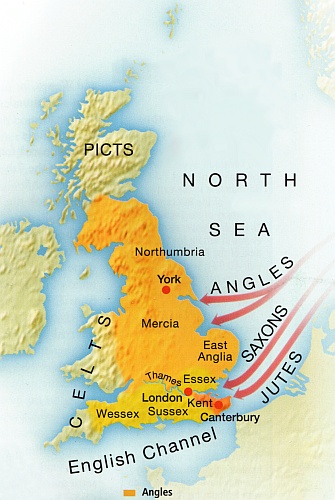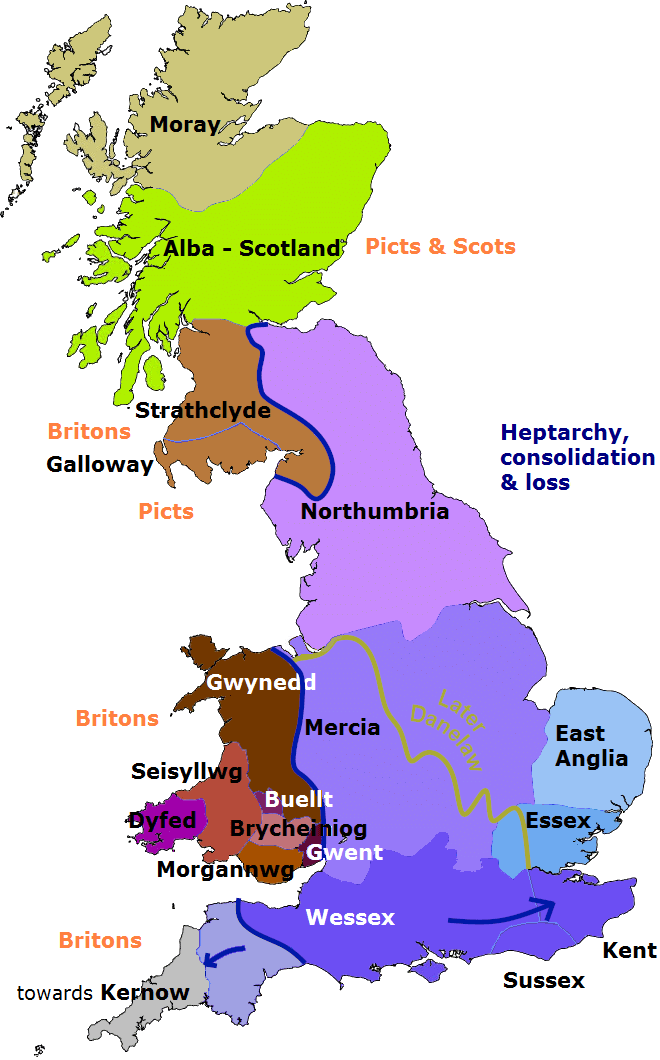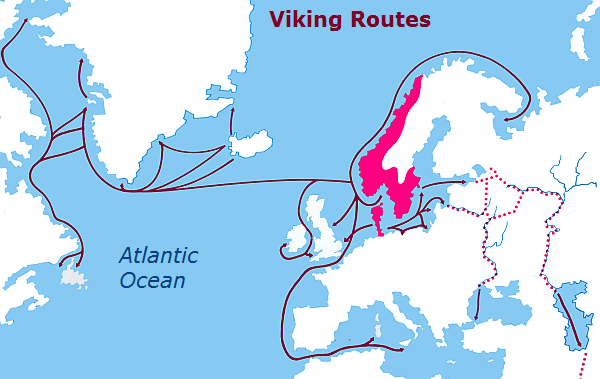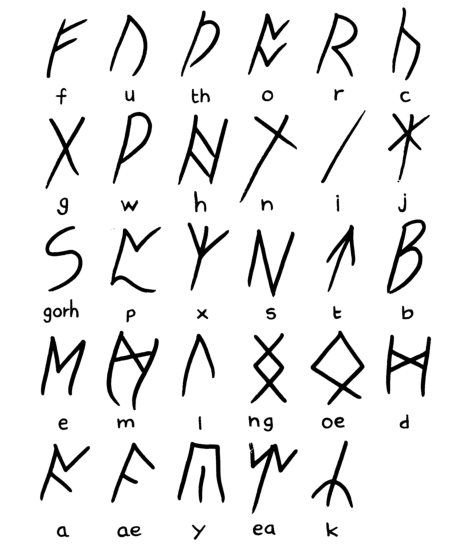
| 430 | First of all men only will have sailed in boats 25 yards long by 4 yards wide carrying 40 to 50 each. | Vortigern seeks assistance against the Picts, but after help the Angles, Saxons and Jutes become aggressors. | Roman towns provided some defences for Britons who fled west or assimilated. |
| 430-600 | Angles and Saxons settle in Britain. | Hengist & Horsa (myth). | British tribes put up a long and stubborn resistance for some 200 years. |
| About 461 | Death of St. Patrick. |
Spread of Christianity. Perpetual warfare, especially against Penda of Mercia. Myth of Briton King Arthur (author Welsh monk Nennius, writing 830 CE). |
|
| About 560 | St. Columba in Scotland. | ||
| 597 | Pope Gregory. | St. Augustine in Kent. | |
| About 603 to 680 | Kings Edwin, Oswald, Oswy of Northumbria. |
St. Aidan. Abbess Hilda and Caedmon. Bede (672-735). |
|
| 757-96 | King Offa of Mercia. | Offa's Dyke. | Period of the Heptarchy (or Seven Kingdoms). |
| 825 | Egbert ('the Great') of Wessex, first King of all England (802-836). | Defeated Mercia at Battle of Ellanddune. | Saxon open-field system in Agriculture. |
| About 835 | The Danes. | Viking raids. | E. Anglia, North and Midlands overrun. Christianity destroyed temporarily. |
| 871-99 (or 900) | Alfred (Aelfraed) the Great, King of Wessex. | Inevitable clash with invaders. | Born 849 Wantage, youngest of Aehtelwulf King of Wessex. Discovered England by hunting. Learnt poetry by ear and writing after 12 years old. |
| 878 | Guthrum defeated at Ethandune. Peace of Wedmore. Anglo-Saxon Chronicle. | Stiff resistance against Danes but 878 hid in Somerset Marshes to then attack Guthrum in Edington. Guthrum withdrew, became Christian, each respected the other. Either under Danes or under Wessex. Thus division of England into Danelaw and Wessex. | |
| 900-24 | Edward the Elder. | Reconquered Danelaw. | Great period of Wessex kings |
| 925-50 | Athelstan. | Conquered south Scotland. | Spread of building and learning. |
| 959-75 | Edgar. | St. Dunstan. | lncreased power of the Church |
| 978 | Ethelred the Unready. | New Danish raids. | Danegeld payment. |
| 1013 | Sweyn of Denmark. | Invaded Britain. | |
| 1016-35 | Cnut. | Edmund lronside fought him. | Cnut ruled an Anglo-Danish Empire. |
| 1042-66 | Edward the Confessor. | Introduced Normans. Built Westminster Abbey. |
Danes built towns and fostered trade. Use of stone for building. |
| 1066 | Harold (son of Earl Godwin of Wessex). | Defeated Tostig and Harald Hardrada at Stamford Bridge (nr. York) | William of Normandy prepares to invade. |

In 395 CE no more Roman coins were sent to Britain. This was the beginning of the end. Pottery became more crude. Then the Romans withdrew, leaving defence to the British. A residual number of Christians continued into the Anglo-Saxon period. Vortigern is said to have requested help from overseas to resist the Picts, who were pushed back.
It is not possible to describe with any certainty the incursion of Angles, Saxons and Jutes (as Bede categorised them) into British space. Unlike for the Roman period, literary evidence is scant. A Celtic cleric Gildas attempted a description of earlier raids in his Ruin of Britain completed about 550 CE. It was a call for the Romano-British to repent of their sins, for which the invasions were evidence of wrong-doing. He described cities as ' 'deserted and dismantled', and this was written during a lull in foreign invasions but with domestic battles continuing. Bedes Ecclesiastical History was completed in 731 CE and relies much on oral tradition to describe centuries earlier. He uses the phrase 'it is said', for example about Hengest and Horsa being brothers who led the Anglo-Saxon invasion, who could trace their ancestry back to Wodan. Their names mean Gelding and Horse respectively, and they likely never existed but were used to give early Anglo-Saxon chiefs genealogical legitimacy.
British chieftains known as 'tyrants' were left to fight off the Scots and Picts, but the new culture came from the east. From 450 Saxons established themselves on the east coast from The Wash down and in Sussex. Angles were said to come from between the Elbe estuary and Jutland, settling in the north and in parts of East Anglia. Bede said that Saxons came from the lower Elbe and settled in Essex, Wessex and Sussex, and the Jutes came from undefined localities to Kent (under the supposed Hengest). A British victory at an unknown Mount Badon halted the larger scale incursions until the mid 550s on. And whereas Celts had lived on and left the hill-tops, the Saxons preferred to farm the valleys and away from the cities (except London, Canterbury, Lincoln and York).
The rise of the Anglo-Saxons was as much a cultural phenomenon as simply conquest by battle. Not all Celts fled: the Celts may have changed. The new English may also have had a higher birthrate, so that over time they produced the new, dominant population.
They didn't have a sense of national origins, so ended up in England as competing warlords. The so-called Heptarchy developed, if it was seven. Mercia absorbed Middle Anglia and Lindsey, so it and Northumbria were important, but before the Vikings came Wessex rose in prominence. Essex, Sussex, Kent and East Anglia were kingdoms facing attack from others. Penda, King of Mercia (c634-656), took an interest in East Anglia, and he and Ethelhere of East Anglia in alliance were killed by invading Northumbrians in 656. Noirthumbria at first was divided between Beira, from the Humber to the Tees, and Bernica, from the Tees north. It took until 635 for the Bernicans to fix Northumbria as one unit, and these were attacking many nearby kingdoms, including into Gwynedd and the Isle of Man. The Picts prevented Northumbria having success against Mercia. In the 700s internal rivalries created peace with Picts and Mercians. Mercia absorbed neighbouring lands and held off the Welsh. Offa (758-796) arose in Mercia controlling Essex and making Kent dependent, defeating the West Saxons at Bensington in 779 and sought parity regarding marriages with offspring with Charles the Great, King of the Franks, from 800 Emperor Charlemange. He and his eventual successor Cenowulf (796-821) tried to control the English Church. Offa's Dyke earthwork did not end conflicts with the Welsh. Egbert (802-839) of Wessex waited until 825 when defeating a Mercian attack at Wroughton and thus immediately demanded and received the subjection of Kent, Surry, Sussex and Essex. Smelling weakness, the East Anglians defeated Mercia in 825 and 827. Egbert unexpectedly defeated the Mercians in 829 and even achieved submission of the Northumbrians. His successors were regarded as paramount even if they lacked control in Mercia, Northumbria, London or East Anglia. But then the Vikings came.
After the Romans, Christian congregational worship broke down and the faith retreated into Wales. Paganism resurged with the newcomers. Christian Celtic bishops ran monasteries not dioceses but had similar doctrinal views as to the more direct Roman side. Differences on dating of Easter were sorted out at the Synod of Whitby (summonsed by Oswy of Northumbria in 663 or 664) in favour of the Roman date and thus the influence of Rome more directly. Augustine's mission had limited success - it suited Ethelbert in Kent to be Christian and be closer in identification to the Romans over the water. He commanded the East Saxons and East Angles to become Christian, and Augustine established bishoprics in Rochester and London. Laurentius succeeded Augustine and frightened Eabald into baptism (on a tale that Laurentius was considering giving up his mission to England, that then St. Peter visited him in a dream, and then Eabald was showed the real sourge marks on Laurentius's back). The Northumbrian mission failed because Penda of Mercia was a heathen, and he defeated and controlled Northumbria, and it took the Celts to bring Northumbria into Christianity. Thus Oswald was converted by Celts before becoming King of Northumbria 634-5. Oswald requested Aiden be made bishop and he began a mission based at Lindisfarne, converting Northumbria, Mercia and the East Saxons. Only Kent was fully Roman in 660 and thus the Synod of Whitby. Theodore of Tarsus, an ex-Orthodox Greek scholar Archbishop of Canterbury from 669, assisted by an Italian based African monk Hadrian, consolidated Roman authority (if still Celtic spirituality) afterwards. He set up super-large parishes, with monasteries as key to expansion of the faith, with minsters established in various farming town locations. Oswy of Northumbria (643-671) established the allied monasteries of Wearmouth and Jarrow, and one of the first novices was a certain historian Bede (c672-735). St Aldhelm (c639-709) was a notable Anglo-Saxon scholar. The Church gave rise to centres of education.

The northern route of attack by the Vikings came from the Norwegians and a few Danes. Landing in Ireland, they actually attacked England from the west as well as the east, thus leading to a prospect of a Viking land from Dublin to York (around 950). Between the 780s to 870s, the southerly route of Danes involved the Rhine, northern Gaul and into England. Meeting eventual resistance, the Vikings nevertheless grasped strongholds in East Anglia, Northumbria, Mercia and Nottingham by 867 and Reading in 870.

This was what forced Alfred initially to make peace in 871. In 874 the Vikings imposed a puppet king in Mercia. That a Danish force went in 874 to Strathclyde and move on Bernicia gave enough potential for the English to respond. Nevertheless, Guthrum leading a Danish force in 878 took Chippenham by surprise and therefore a chunk of Wessex.
Alfred went hiding in the Somerset Marshes and from a fortified Isle of Atheney carried out guerilla raids on the Vikings at Chippenham. He was able to pull in sympathisers from West Saxons in Hampshire, Wiltshire and Somerset to attack Guthrum in Edington in the Wiltshire Downs early in the summer of 878, besieging Guthrum at Chippenham for two weeks. And then Guthrum agreed to leave Wessex, become a Christian and even stayed with Alfred for some days at Wedmore in Somerset after his baptism. Guthrum moved away to Cirencester and then East Anglia in 879 and later put troops into Gaul. So Alfred was able to attack the remaining Danes and achieved control of London in 886, at which Guthrum and he demarcated Danish and English rule.
The Danelaw ran along the Thames and Lea to Bedford, along the Ouse for Watling Street going across to Chester.
Guthrum had been practical because he was letting Danish population centres settle in. Alfred had been an opposition too far, and it was unnecessary to stretch further in land. Incoming Danes had enough productive lands to settle, including new lands for them of Suffolk and Essex, and others could focus on the problems of disease and productivity where they were. The Danes still had to fight to the north, so peace to the south was useful.
Alfred could also better resist a Danish attack from Gaul in 892, and had ships to tackle the Danes' fluency with the sea. He reorganised the Saxon fighting force, the Fyrd, so that instead of calling upon men in a crisis, always some were ready to fight, some guarded fortresses and some farmed. The network of fortresses was improved so considerably that they became centres of trade and government. Alfred's organised leadership against the Danes became an alliance so that he gave London back to the West Mercians (the original occupiers). The Wessex and West Mercians battled together and resisted Danish attack in 893, and Alfred helped break up any effective alliance between the Welsh in Gwynedd and the Danes in Northumbria at York. He gave his daughter Aethelflaed into West Mercia as a bride and indeed went on to rule West Mercia herself after her husband's death. Alfred died in 899.
Alfred's son Edward the Elder (899-924) retained the alliance with West Mercia. Beating the Danes of Northumbria meant they having to declare acceptance of English overlordship of southern England. Athelstan in 924 became King of both Wessex and West Mercia and was successful in battles all around, including the submission of Northumbria and confining the Cornish in Kernow to west of the Tamar. These achievements were not permanent, and subsequent Kings suffered losses - under Edmund and Eadred, Mercia and Northumbria were not under their control. Edgar of Wessex (959-975) was however lucky to live in a period of peace regarding the Vikings, with ships to guard the coast and a war in Morgannwg.
In 978 Edgar's successor Edward was killed perhaps by Ethelred's mother and others and he was replaced by Ethelred, at only eleven years of age. His much later Ethelred the Unready tag was derived from his nickname meaning evil counsel (unraed) but he was disliked and created opposition within. Via peaceful administration, and lack of reach from a King's perspective, some powerful individuals in Northumbria and Mercia had developed power and internal quarrels, especially out to the north and west, and he kept trying to take it back from them. He was arbitrary and unpredictable. The Danes were thus able to attack more easily, but there was a united Kingdom of Denmark to do it focussed on England. However, Ethelred taxed his population and paid off the Danes from the 990s to 1012.
Olaf Tryggvason, King of Norway, became focussed on attack in England and defeated Essex in 991 at Maldon, a local battle; hit and run tactics continued in such battles when Ethelred's army was larger than the Danish.
In 1002, Ethelred ordered the assassination of a number of his Danish subjects called the massacre of St Brice's Day (13/ 14 November). The sister of Swein Forkbeard, King of Denmark, was one of the victims and so he took over directions by 1013. Swein's arrival at the Humber then produced the submission of all the Danelaw; after an undisciplined sacking of Canterbury, the damage inflicted in Wessex was such that Ethelred fled to Normandy. A year on Swein died, so the Danelaw submitted to his eighteen-year-old son, Cnut. The West Saxons nevertheless took Ethelred back as their 'natural lord' but begged him to rule more justly. An unresponsive Ethelred died himself in 1016, succeeded by his son, Edmund Ironside. Edmond, however, was defeated by Cnut at Ashingdon in Essex and so all the Danelaw went to Cnut and Edmund died shortly afterwards. The West Saxons therefore finally accepted Cnut as their king. What the West Saxons really wanted was stable and good governance.
Cnut offered stability and his prestige. Cnut showed willingness to respect the traditional differences between English and Danish law, as Edgar of Wessex had done. In 1027 he visited Rome timed to coincide with the coronation of the Holy Roman Emperor so that he could appear not only as a devout pilgrim but as a prince with other princes on this great occasion. But conqueror he was and demanded a huge further instalment of Danegeld to compensate those Danish forces that were returned to Denmark and then regularly imposed the tax called the heregeld. This paid for a navy and for an army that collected the taxes to pay its own wages. Cnut also gave military chiefs large territorial earldoms. Their loyalty, and the devotion of leading churchmen, as well as the efficient military, gave security and peace in England. He died in 1035 when still a young man, and so the succession was argued about between his two sons and the two sons of Ethelred the Unready.
Weakened by these rivalries, the actual outcome was going to be rule by the Duke of Normandy or the King of Norway. The legacy of Wessex, English Mercia and the Danelaw would be felt well after the Norman conquest. There was some doubt too about the extent of Scotland coming south, being something of bandit country later on in Northumbria.
The Vikings at first damaged Church properties and documents; some bishoprics disappeared for ever, and monks and bishops were forced into hiding. The library at York, one of the greatest in eighth-century Europe, was destroyed, and the Minster for 300 years before 1066 had to be held in plurality with the rich diocese of Winchester. The Lindisfarne community ran off to Ireland before returning to Durham at the end of the 900s. The Danelaw was everywhere settled by Pagan Danes and many English joined them.
The model origin of devotion was from Alfred. He encouraged learning in the Church, a basis for literacy in Latin (the worldwide language) and Anglo-Saxon English (to understand it locally). The Anglo-Saxon Chronicle was to be in English showing the struggle of Alfred and successors against the Danes. Yet the once heathen Danes were easily converted to Christianity, it seen as offering additional magic. The Church accommodated itself to Pagan forms although Cnut tried to forbid the worship of 'heathen gods, and the sun and moon, fire and flood, water-wells or stones, or trees of the wood of any sort'. Whilst these gods offered protection to some, baptism into Christianity from Alfred on meant joining a worldwide monotheistic community, a membership beyond Christian burial into eternity. As Christianity recovered, feudal lords provided a church and a living for a priest and parishes took over as key units from monasteries with their Benedictine Rule (poverty, chastity and obedience with liturgical regularity). Dunstan was a key reforming Archbishop of Canterbury, enhancing Edgar's reputation, to impose monastic Benedictine discipline in various centres such as cathedrals and at Winchester and Worcester. Dunstan and Aethelward introduced the Benedictine Regularis Concordia for liturgical activity and supporting labouring. But in time the monasteries served the parishes. The number of churches in locations grew. The Church grew in wealth, and so did landowners receiving an initial payment from an incumbent and then renting out their property to the priest. This priest was dismissable by the landlord. Influenced from Wessex, the Church also received annual harvest money (by Martinmass, 10 November) and there were penalties introduced by Edgar and Cnut for non-payment. Government was almost theocratic in nature, Cnut himself combining spiritual and temporal authority. English Churchpeople regarded the King as one of their own (unlike in the cluniac reforms on the continent - monasteries escaping diocesan control) and bishops were part of achieving national unity and informally intermingling with the aristocracy. Prelates of the Norman Conquest were surprised by the ecclesiastical informality and expected better organisation. Poverty and chastity were ethical markers for English laypeople with riches put under judgment alongside the more practical reality that imposed poverty on so many.

| Alfred 871-899 Defeated the Danes and saved Wessex. | ||||
|
|
|
||||
| Edward the Elder 899-925 Son of Alfred, Conquered the Danelaw. | ||||
|
|
|
||||
| Athelstan 925-940 Defeated the Danes. Became first true king of Britain | Edmund 940-946 Brother of Athelstan. Murdered after a reign of 6 years. | Edred 946-955 Brother of Athelstan. | ||
|
|
|
||||
| Edwig 955-959 Nephew of Edred. A weak king who lost territory. | Edgar 959-975 Regained strength and headed 'The Golden Age of the Saxons'. | |||
|
|
|
||||
| Edward the Martyr 975-978 Son of Edgar Murdered. | Ethelred 978-1016 Son of Edgar. Known as the 'Unready'. Faced a major invasion by Danes. | Edmund lronside 1016 Stronger than his father, Edgar, Defeated Danes. Died at a young age. | Alfred the Atheling Did not become king. | |
|
|
|
||||
| Edward the Confessor 1042-1066 Son of Ethelred. More concerned with church matters. Left running of Kingdom and ultimately the succession to Harold Godwinsson. | ||||
|
Kings not of Alfred's family: Cnut 1016-1035 Harthacnut 1040-1042 Harold Godwinsson 1066 |
||||
Tables from: Palmer, J. (1992), History: Key Stage 2 Teacher's Resource Book, National Curriculum Blueprints, Cheltenham: Stanley Thorne (Publishers) Limited.
Some text from consulting: Reader's Digest (1973), 2 The Fires of Faith, Milestones of History, Second edition, London: George Weidenfeld and Nicolson, '886 England for the English', 74-78.
Image from: Reader's Digest (2006), Between Cross and Crescent: 430-907, Reader's Digest Illustrated History of the World, London: Reader's Digest Association Limited, 25.
Most text from consulting: Seaman, L. C. B. (1981), A New History of England: 410-1975, Brighton: The Harvester Press, 4-33.
Adrian Worsfold
Pluralist - Liberal and Thoughtful